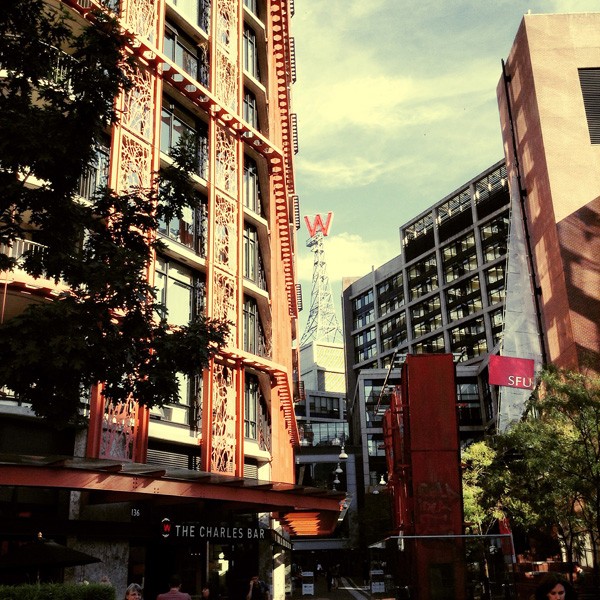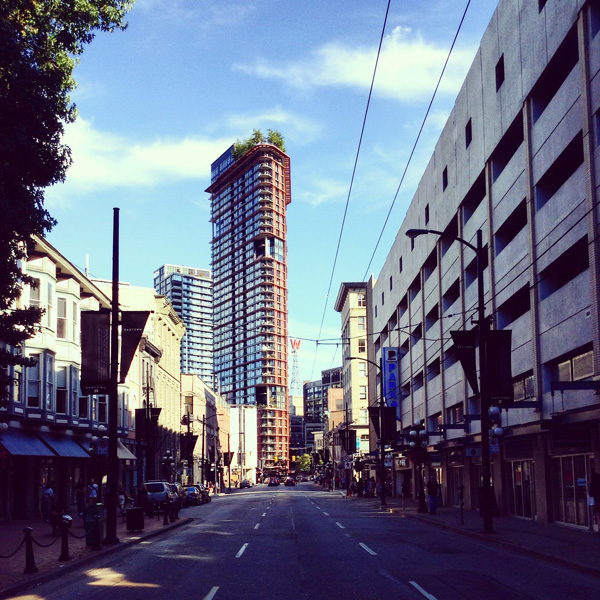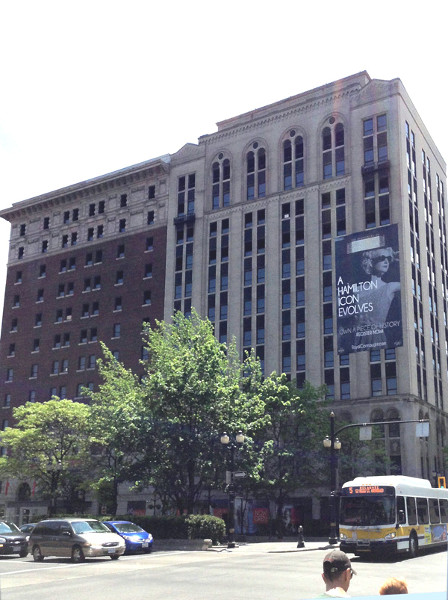Vancouver's Woodward's Project incorporates mixed-income housing whereas Hamilton's Royal Connaught does not.
By Ulduz Maschaykh
Published October 27, 2015
For cities to be healthy and happy, researchers have increasingly emphasized the importance of implementing inclusive cities - urban environments that enable human encounters and daily interactions between people, families and groups. Consequently, combining inclusivity with urban revitalization can result in healthy, growing cities.

Woodward's Building, Vancouver
Providing every citizen - no matter what their income level - with livable housing options that they can afford is critical for inclusive cities, given that how people dwell has a significant effect on people's physical and mental well-being, and sense of belonging.
Vancouver sets a strong focus on becoming and remaining an inclusive city. Despite its label of being North America's least affordable city, Vancouver has a number of high-quality, innovative affordable housing options.
One of the most promising forms of inclusivity is in mixed-income housing and, with this in mind, certain cities can be described as more inclusive than others, based on their approach to affordable, mix-income housing.
The relatively recently redeveloped Woodward's Project in Vancouver's Downtown Eastside, for example, challenged the mainstream idea of gentrification at the time, by integrating 200 housing units for low-income residents with the intention of minimizing their displacement. As such, it can be seen as a project that embodies the spirit of creating an inclusive city.
The high-end Royal Connaught redevelopment in Hamilton, Ontario, on the other hand, contrasts the latter, explicitly showing the effects of short-sighted planning. Both projects are instructive and worth exploring.
Completed in 2010, just prior to the Vancouver Winter Olympics, the completed Woodward's project encompasses virtually the entire block bounded by West Hastings Street, West Cordova Street, Cambie Street and Abbott Street.

Woodward's Building, Vancouver
The late nineteenth century department store functioned as an important hub for commercial activity and consumer culture across Alberta and British Columbia. The design of department stores' buildings, as well as their locations, were key to their success. Often times their architecture were landmarks due to their size and distinct architectural features.
The construction of space is bound to the creation of class, power and culture. Henri Lefebvre's triad spatial model suggests that cities are organized around three types of space - perceived space, lived space, and constructed space - each of which contribute to the construction of space and are relevant to the discussion around inclusive cities.
According to the model, perceived space is space produced by society in a subtle manner. It is revealed and concealed, in turns. In the production of space, it implies the production of physical infrastructure, such as transport and communications.
The lived space is a 'Representational Space' that is symbolic, fluid and subjective, perceived by people through childhood memories, dreams and symbols. The type of space is lived directly and includes lived situations and actions. Therefore, it implies time, the present and past.
Last, constructed space refers to the representation of space as conceptualized by architects, urban planners, scientists, etc. The result is reflected in products such as maps, mock-ups, and drawings.
Lefebvre's triad spatial model has become instrumental in people's movement to claim their "Right to the City." Implementing this right enables citizens to reshape the city in a more socially just, egalitarian and environmental sustainable way.
The realization of Woodward's redevelopment as a mixed-income dwelling project is symbolic for the active involvement of Vancouverites in the development if their city.
The strongest execution of this Right to The City may be in the Woodward's Squatters who occupied the, then abandoned building and demanded it to become affordable housing. In doing so, they took control of the perceived space that, through the realization of the 200 affordable housing units, became part of the constructed space.
The fact that the Woodward's Redevelopment became a success in mixed-income housing is also due to the active involvement of citizens and activists, who fought for their Right To The City and made this project happen.
Within this context, Hamilton, Ontario lies in contrast to Vancouver, insofar that it shows how a lack of people's involvement in the decisions that shape their city, negatively effects the urban planning strategies.

Royal Connaught Hotel
The former luxury hotel Royal Connaught is set in one of Hamilton's poorest neighbourhoods, Beasley, which has a poverty rate of 57 percent. There are many similarities between it and the Woodward's building in their historical past, architectural present and overall setting. Like the Downtown Eastside, Beasley is experiencing a major redevelopment, with new commercial businesses opening up and many of its deteriorated and old buildings being reused.
Similar to the Woodward's department store, the Royal Connaught was built in the first decade of the twentieth-century and encompasses an entire block edged by King Street East, Main Street East, John Street South and Catharine Street South.
The style of the thirteen-storey building is associated with the Commercial style that emerged during an era in Canada's architectural development where commissioning the services of a professional architect became increasingly en vogue.
Large corporations, successful newspaper publishing companies and wealthy private dwellers had these high-rises built as a monumental expressions of their enterprises and a belief in the future growth of their city.
Consequently, the redevelopment of the Commercial Style became an ideal selling point for developers in the twenty-first century, as these buildings encompass the memory of a prosperous past, while visually embodying the zeitgeist.
Throughout the decades, the Royal Connaught changed ownership and stood empty starting 2004. In 2009, it was officially announced that Hamilton would be one of the hosts of the 2015 Pan Am Games, triggering the city to clean up its deteriorated downtown neighbourhoods - Beasley being one of them, with a major focus on the empty and deteriorated Royal Connaught hotel.
In 2008, discussions began around turning Hamilton's landmark building into an affordable housing project to house its many low-income residents. But community did not like this idea, with NIMBYism leading the way to its rejection.
Unlike the Woodward's project, where people protested for days and community leaders called for action to raise awareness of the need for inclusive housing, there was no active involvement or intervention by the low-income community in Beasley to convert the Royal Connaught into low-income housing.
Thus, the proposal to turn the Royal Connaught into a mixed-come housing project failed, not only due to a lack of funding through the Federal and Provincial Government, but most importantly since it was not supported by local residents who do not understand the need for mixed-income housing and its critical role in creating a healthy, inclusive city.
Instead, the Royal Connaught is currently being redeveloped into a high-end mixed-use condominium project that caters to the financial means of Hamilton's upper-class clients.
Evidently, Hamilton's deteriorated downtown neighbourhood needs middle-class and upper-class residents to boost the economy. But what will happen to the many low-income residents, who have considered the downtown as their home for many decades?
Building cities on the principle of inclusivity fosters mutual understanding and the community spirit, that may lead to happier and healthier citizens. The more people are given a say in how their urban environments are constructed and perceived, the more equal and sustainable their constructed space can be.
The Woodward's Redevelopment is an example of how the active involvement of citizens leads to the realization of a mixed-income dwelling project that speaks to inclusivity, whereas the Royal Connaught in Hamilton neglects to include the city's vulnerable population.
This article was first published in Spacing Vancouver on September 14, 2015. It is republished here with permission.
By kevlahan (registered) | Posted October 27, 2015 at 10:59:03
This is an interesting article comparing two developments in two Canadian cities.
Now that Hamilton seems to be finally undergoing a development renaissance, it is important to start thinking about how to ensure affordable housing is incorporated into new developments or that new affordable housing is built.
However, I do think there are a lot of important differences between the two developments.
First, the old Woodward building was actually bought by the City of Vancouver in 2003 with the explicit goal of building a mixed-use, mixed-income development.
The Connaught was always privately owned, and the affordable housing proposal never seemed very serious or well-thought out. It was just an attempt to find some sort of use for the building that would allow the owners to make some money, financed by the public.
Any NIMBY opposition did not lead to the affordable housing project failing. It failed because it was not successful in attracting the grants it needed! The city actually recommended it as their top request for funding:
https://raisethehammer.org/blog/1501/cit...
It is important not to mis-represent the history of the project!
The context is also important. Vancouver has hundreds of recently constructed high end condominium buildings, development pressure is enormous, and the Downtown Eastside is one of the last areas to face re-development pressure. The Downtown Eastside is also unique in Canada in its combination of extreme poverty and extremely high proportion of drug users, violence and drug dealing. And it has been that way for decades.
The situation in Hamilton is quite different, with no new condominium buildings constructed for decades downtown or adjacent neighbourhoods and only a handful of conversions. The social situation is also quite different, as anyone has has spent time in both places can see (I used to work part-time at the Carnegie Library). The Connaught is an exception in Hamilton, whereas in Vancouver this sort of high end development is the rule.
Going forward, Hamilton will need to start working with developers to ensure a proportion of geared-to-income housing. But Hamilton is still extremely far from the huge development boom that Vancouver has experienced for the past 30 years. And it should be remembered that Vancouver's creative trade-offs are in part made possible by the high value of the developments.
Comment edited by kevlahan on 2015-10-27 11:06:59
By jason (registered) | Posted October 27, 2015 at 18:39:19
Very interesting piece, but I'm not sure the comparison is valid. Vancouver has built virtually nothing but gazillions of condo buildings in the past few decades. Hamilton has just seen it's first condo constructed since the 1990 Bentley Place. Our core has been one of the cheapest neighborhoods in Canada for years. Vancouver is the most expensive city in Canada.
I like the idea of a minimum # of affordable units in new buildings, but also have no problem with the Connaught being the first market price condo to be built in Beasley perhaps in my lifetime.
By Huh? (anonymous) | Posted October 27, 2015 at 20:40:25
I wonder if the author can find 1 similar project in Toronto that includes low income units?
Most of the units in Connaught would be considered low income by Vancouver standards.
By fmurray (registered) | Posted October 27, 2015 at 22:03:29 in reply to Comment 114386
Thank you for the context, Nicholas. Having never lived in Vancouver, I would not have been able to criticize the viewpoint in this article, although my reaction to the Royal Connaght repurpose was one of great relief.
By highasageorgiapine (registered) | Posted October 28, 2015 at 10:16:32
perhaps having the foresight to initiate mixed income development during a period of initial urban renewal rather than let the desirable inner core of the city be developed for the rich only would be an intelligent and rational way to planning that ensures long term prosperity for the community as a whole in economic, health, and social aspects.
or we can just hop on the gentrification bandwagon like many of the above commenters and say that it's okay to push low income people away from areas close to essential services and employment because we will maybe, eventually mandate mixed income housing somewhere.
saying "vancouver and toronto didn't do these things so why should we?" is pretty narrow sighted as both cities are rife with planning problems.
By kevlahan (registered) | Posted October 28, 2015 at 10:39:51 in reply to Comment 114390
I agree that we need to set up guidelines and policies to achieve an good level of affordable housing. A good target is 20%, which is what France imposes on municipalities and corresponds roughly to the overall proportion of those on low incomes.
One lesson from Vancouver is that increased values give more latitude to cities to negotiate with developers to provide geared to income housing. If no one wants to build and values are low it is very difficult to achieve anything. Increasing desirability and values will provide the opportunity to improve conditions for everyone, if we take it seriously.
We also need to be careful about throwing around the term "rich". The current developments in downtown Hamilton are certainly NOT for the "rich": they are aimed mostly at middle incomes or lower (e.g. the Spallacci block and the Vranich rental apartment developments as well as the new rentals being developed on King William). At $250k to $371k the Connaught condos are certainly not aimed at the "rich"! (Compare to Vancouver where the average house price is now well over $2 million and the high end condos are in the $5 -20 million range. Now that's rich! http://www.realestatevalley.ca/vancouver... ... 24 pages of condos over $1 million.)
Comment edited by kevlahan on 2015-10-28 10:47:20
By watman (anonymous) | Posted October 28, 2015 at 10:40:06 in reply to Comment 114390
The Connaught redevelopment isn't pushing anyone away, it's been vacant for many years.
By highasageorgiapine (registered) | Posted October 28, 2015 at 12:07:40 in reply to Comment 114391
you also have to consider that housing costs in vancouver take up approx. 80% of an individuals income, which is unsustainable. also those low costs for a condo are for something like a 1br or bachelor... so for one/two people that is fairly expensive when you include condo fees. perhaps not "rich" but certainly above what would be the median income for this city.
By Dylan (registered) | Posted October 28, 2015 at 17:45:51
Why would we need subsidized apartments in a condo building that stands amidst a sea of low income rentals? It will take at least a decade before we have to worry about renters being priced out of Beasley.
The condos that are for sale in the Royal Connaught exceed the price tag for homes in this neighbourhood, in some cases radically.
Making accommodations for those potentially deposed by gentrification should not be at the cost of said gentrification. All developments must be approved for financing. Start putting unreasonable constraints on developers that cut into their projected profits and they don't get financing, and there is no project.
By LOL_all_over_again (registered) | Posted November 04, 2015 at 13:49:42 in reply to Comment 114386
By JasonL (registered) | Posted November 04, 2015 at 13:52:10 in reply to Comment 114613
imagine taking the billions of dollars away from constant and unnecessary road widenings and new highways we don't need and putting it towards a few projects like that? WOW!
Comment edited by JasonL on 2015-11-04 14:52:34
By DTES Resident (anonymous) | Posted November 14, 2015 at 16:40:32
Adore the Woodwards Project ...it is a meaningful model of inclusivity.
By korerealty (registered) - website | Posted February 02, 2017 at 13:36:08
Very interesting piece, but I'm not sure the comparison is valid. Vancouver has built virtually nothing but gazillions of condo buildings in the past few decades. Hamilton has just seen it's first condo constructed since the 1990 Bentley Place. Our core has been one of the cheapest neighborhoods in Canada for years. Vancouver is the most expensive city in Canada.
I like the idea of a minimum # of affordable units in new buildings, but also have no problem with the Connaught being the first market price condo [ http://www.korerealty.com/canada-mls-lis... ] to be built in Beasley perhaps in my lifetime.
You must be logged in to comment.
There are no upcoming events right now.
Why not post one?